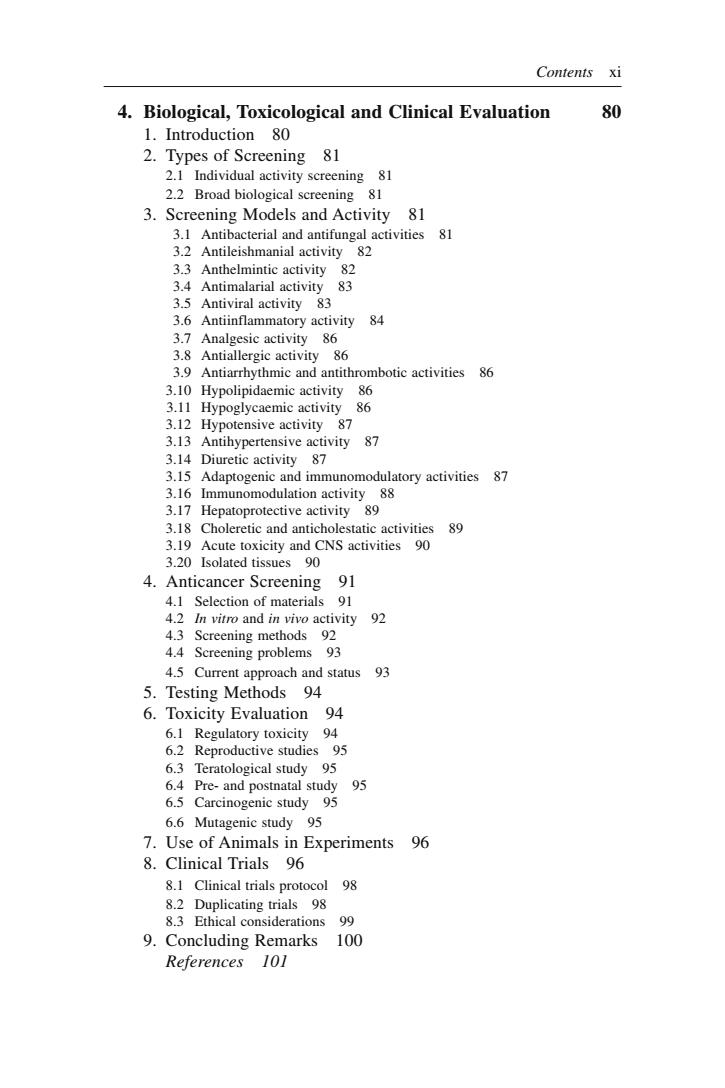正在加载图片...

Contents xi 4.Biological,Toxicological and Clinical Evaluation 80 1.Introduction 80 ning 81 Individual ac ning 8l 2.2 Broad biological screening 81 3.Scr ing Models and Activity 81 站 rial and antifungal activities 81 82 3 5 Antiviral activity 83 3.6 Antiinflammatory activity 84 3.9 Antiarrhythmic and antithrombotic activities 86 86 87 tivity 87 314 Diuretic ac vity 3.16 Immunomodulation activity modulatory activities87 88 3.17 Hepatoprotective activity 89 9 eretic and ar nd CNS 89 3.20 Isolated tissues 90 4. Anticancer Screening 91 91 43 nd 4.4 Screening problems 93 4.5 Current approach and status 93 5.Testing Methods 94 6.Toxicity Evaluation 94 6.1 Regulatory toxicity 94 6.2 Reproductive studies gic 6.5 Carcinogenic study 5 6.6 Mutagenic study 95 7.Use of Animals in Experiments 96 8.Clinical Trials 96 8.1 Clinical trials protocol98 8.2 Duplicating trials 98 8.3 Ethical considerations 99 9.Concluding Remarks 100 References 101 Contents xi 4. Biological, Toxicological and Clinical Evaluation 80 1. Introduction 80 2. Types of Screening 81 2.1 Individual activity screening 81 2.2 Broad biological screening 81 3. Screening Models and Activity 81 3.1 Antibacterial and antifungal activities 81 3.2 Antileishmanial activity 82 3.3 Anthelmintic activity 82 3.4 Antimalarial activity 83 3.5 Antiviral activity 83 3.6 Antiinflammatory activity 84 3.7 Analgesic activity 86 3.8 Antiallergic activity 86 3.9 Antiarrhythmic and antithrombotic activities 86 3.10 Hypolipidaemic activity 86 3.11 Hypoglycaemic activity 86 3.12 Hypotensive activity 87 3.13 Antihypertensive activity 87 3.14 Diuretic activity 87 3.15 Adaptogenic and immunomodulatory activities 87 3.16 Immunomodulation activity 88 3.17 Hepatoprotective activity 89 3.18 Choleretic and anticholestatic activities 89 3.19 Acute toxicity and CNS activities 90 3.20 Isolated tissues 90 4. Anticancer Screening 91 4.1 Selection of materials 91 4.2 In vitro and in vivo activity 92 4.3 Screening methods 92 4.4 Screening problems 93 4.5 Current approach and status 93 5. Testing Methods 94 6. Toxicity Evaluation 94 6.1 Regulatory toxicity 94 6.2 Reproductive studies 95 6.3 Teratological study 95 6.4 Pre- and postnatal study 95 6.5 Carcinogenic study 95 6.6 Mutagenic study 95 7. Use of Animals in Experiments 96 8. Clinical Trials 96 8.1 Clinical trials protocol 98 8.2 Duplicating trials 98 8.3 Ethical considerations 99 9. Concluding Remarks 100 References 101